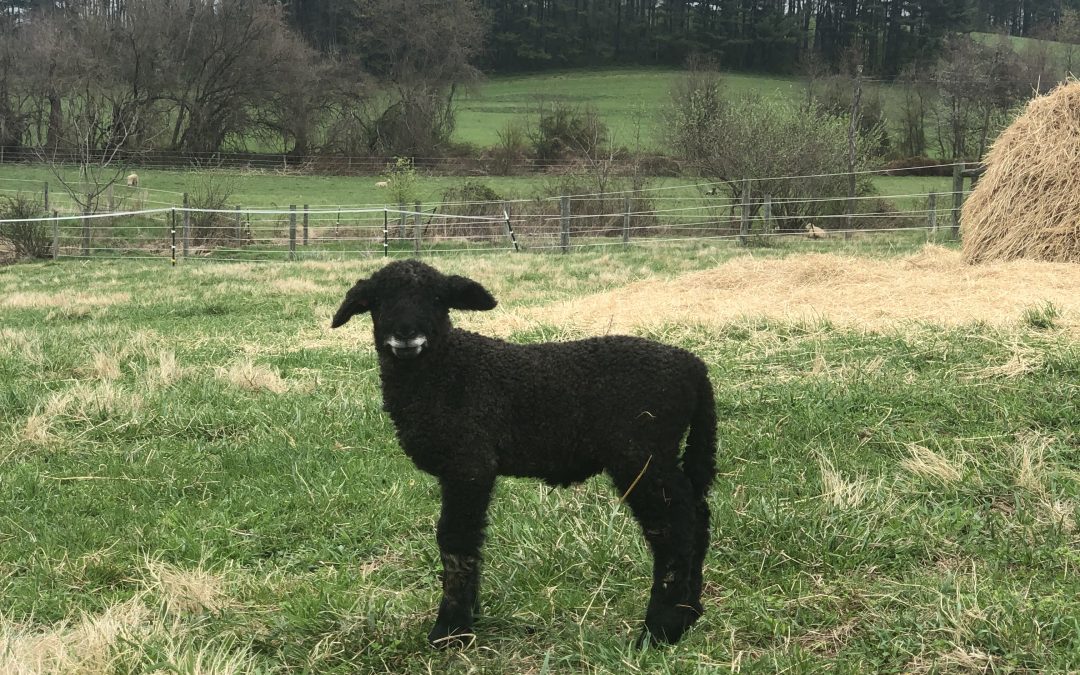Lambing time has come – and gone!
We have 16 lambs, 4 colored ones and 12 white ones bouncing and racing around. We ended up with 6 sets of twins, and 4 large single lambs.
We had to really work on two in order to keep them going. “Shrimpy” was born the evening of 36 degrees and pouring rain and came out at about 4 ½ pounds (normal should be 7 – 9 pounds). She wouldn’t stand and wouldn’t nurse. We brought her into the house, wrapped her blankets and put the hair dryer on her (cold lambs can’t nurse). After milking her mother out we intubated her with warm colostrum 2 times. She spent the night in the house in a dog crate (Heidi loved her!) getting bottle fed every 2 hours. In the morning she went back in with mom who immediately took to licking her and talking to her. This was a HUGE relief – often after a separation, particularly before they have really bonded, a ewe will reject her lamb. So this hurdle was crossed. But she still wouldn’t nurse so we continued with milking and bottle feeding her. Until 3 days later, at the 4:00 am feeding she ‘demanded’ to be put down and went over and started nursing. Although still tiny she has not looked back since and is keeping up with her bigger cousins with no problem.
Our other ‘special needs’ lamb was, and still is, a bit of a mystery. She is a big, beautiful white lamb – but couldn’t get up. Once you picked her up she would nurse and try to bounce around, but fell frequently. A vet examination did not find anything obvious. So we continued to work with her, getting her up every few hours, manipulating her legs as she seemed to have a hard time bending them, and keeping her in a smaller, safe area. At day 13 (as of this writing) she was up on her own in the morning, and running, bouncing, and playing with the other lambs. Not sure we are totally out of the woods but she is definitely improving.
We have also set up the creep feeder for the lambs so they can begin eating grain. This is an enclosed area with adjustable openings so the lambs can get access but the bigger sheep can’t. The lambs will get their first round of vaccinations at about 30 days old (mid May). They are then given boosters 30 days later. (sound familiar?).
In addition to growing lambs May is the start of hay season. Normally we do our first cutting around Memorial Day but given the rain and warm weather thus far we may be able to cut earlier. Hay making is really a 4- step process. First the hay is cut. Then it is tedded or basically stirred about to help it dry. It then is raked into windrows so the baler can pick it up and bale it into either small square bales or bigger round bales. Watching the baling is a real treat. Who would think a machine could scoop up the hay, compact it, wrap it in string, tie the string, and (if small square bales), throw it into a wagon – without computers!
The hop yard really starts to come to life in May. The sheep were moved out the end of April so the hops shoots can start to grow without being nibbled off. The rows have been crowned to help control mildews and the trellis will be tightened. Stringing is then also done by hand in May. This entails running coir twine from the ground where it is held in place with ‘hop clips’ over the trellis wires and back down. The coir twine is made from coconut fiber which provides a rough surface for the hops to grip and is also strong enough to withstand the hop picker.

